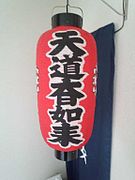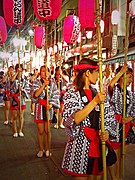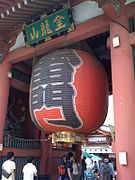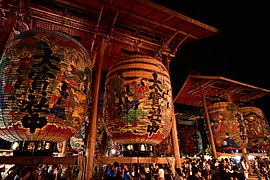Chochin
Chōchin ( Japanese 提 灯 ) are traditional Japanese lanterns . Its basic structure is a spiral made of bamboo, which enables the chochin to be folded up small. The chochin is either covered with Japanese paper ( washi ) or with a PVC film. Originally oil lamps and candles provided the lighting, but today electric light bulbs are used almost exclusively. Chōchin are used at festivals ( matsuri ), parades, in Shinto shrines and Buddhist temples , as decoration in front of or in the house, as souvenirs and in front of restaurants, snack bars and pubs ( Izakaya ).
history
Chōchin were first mentioned in writing in Chōya-gunzai ( 朝野 群 載 ) in 1085. There was a drawing in 1536 of it. Read individually, the characters mean 提 'to carry in your hand' or 'to dangle from your hand' and 灯 'lamp', which suggests that the first Chōchin were not fixed to buildings, but were carried like a lantern and lit the way. From the Edo period (1603–1868) the lanterns were used for festivals and religious ceremonies. By using ordinary candles (instead of the expensive oil lamps) they could now also use ordinary citizens to light their homes. Today, plastic film is used instead of paper for the outdoor area and light bulbs are used as light bulbs.
gallery
Red Chochin with Japanese paper covered
Red chochin of an izakaya covered with PVC film
Red Chōchin in Fushimi Inari-Taisha , Kyoto
White Chōchin in Goryō Shrine, Kyoto
Chōchin above the entrance to kokuritsu bunraku gekijō , Osaka
Chōchin in front of a Rāmen shop (noodle fast food)
Isshiki Lantern Festival ( Nishio , Aichi Prefecture )
See also
- Andon - traditional Japanese lantern made from a wooden or metal frame, covered with Japanese paper












